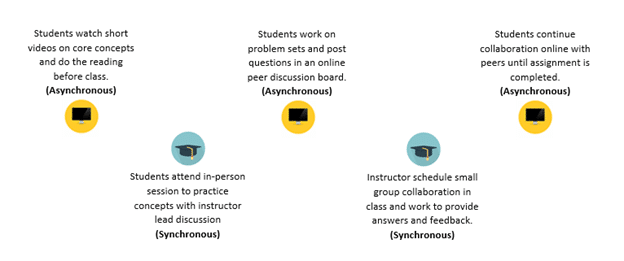Rounding the corner of a wild year where both instructors and students scrambled, and sometimes struggled, to succeed with remote learning, we now need to look forward to what’s next. Do we go back to in-person learning and teaching? Do we continue with the digital and remote curriculum?
Looking back, we can see that some students thrived with remote learning while others struggled to keep up. So how do we find the balance to help them all succeed when it comes to synchronous vs asynchronous learning?
Synchronous vs Asynchronous Learning
Definitions
- Synchronous learning is a learning event that happens at the same time for the instructor and the learners, with real-time interaction. This can happen either online or in-person. (Ed Glossary)
- Students go through a learning path together, accompanied by the instructor who can provide support while students are completing tasks and activities.
- Asynchronous learning is learning that doesn’t necessarily happen at the same time for the instructor and the learners. There is no real-time interaction, and the content is created and made available for consumption later on. (Ed Glossary)
- It’s a student-centered teaching method widely used online where instructors set up a learning path for the students to engage in at their own pace.
Advantages
- Synchronous learning:
- Creates a space for social support among peers and instructor
- Allows students to provide context to their responses and to receive immediate responses from their peers and instructor
- Offers the instructor a chance to clarify misconceptions on the learning materials in real-time.
- Offers direct social engagement and feedback
- Asynchronous learning:
- Accommodates students regardless of location and time zone
- Offers more time and space for students to reflect on their learning and practice, and to refine their contributions to class activities
- Generates an archive of information (i.e., discussion posts, instructor recaps and recorded videos) that students can return to throughout the term
- Provides opportunities for more flexible interaction and communication
Finding Balance
Recent experiences and observations have shown institutions that students can have wide-ranging responses to remote learning. On one end, some students struggle. They’re negatively affected by the lack of peer interaction, immediate instructor feedback, and general social aspects that typically come with in-person learning. However, at the other end, you have those that appreciate the flexibility and the opportunity to dive deeper into the materials that remote learning provides.
So how do institutions and instructors find that perfect balance that will help support students’ cognitive and social needs? Let’s look at the following guide to help determine the right balance between synchronous and asynchronous learning.
What are the essential components of the course?
To design an effective learning model, the instructor needs to examine the course content, learner needs, and course goals. The diagram below shows an example of a course structure that incorporates both synchronous and asynchronous learning activities.
Where are students located?
When creating a model that balances both aspects of learning, consider the physical locations of the students and their time zones. Instructors need to be aware of how and when students will interact with their peers and access learning materials.
What technologies are available to the students?
Instructors must consider the technology available to their students. Do they have the technology that will help maximize both learning and peer interaction? Technology will dictate how instructors develop their lessons and student activities.
How do you keep students engaged?
Students need to feel like they are being heard and know they can engage with instructors and their peers. How do you accomplish this? If synchronous learning is the primary mode of collaboration and discussion, instructors need to consider how they can build in asynchronous engagement opportunities for those students whose location or technology may hinder live engagement.
How Do We Accomplish This?
Now that we know the basics of synchronous vs asynchronous learning, how do we begin implementing them?
Heather Farmer, a Curriculum and Program Review Consultant at Sheridan College, provides six blended synchronous and asynchronous learning models. These range from a highly supported, faculty-guided model to a more independent, self-paced model. Let’s briefly look at each model.
(1) Flipped Classroom: One Hour Asynchronous, Two Hours Synchronous
This model provides time for students to begin learning the concepts and skills of the course asynchronously. It’s most successful if utilized during the first semester. This will help instructors establish behavior expectations and good habits.
Asynchronous learning can all be completed prior to the synchronous component of the course through various means such as videos, readings, or interactive online activities. During the synchronous engagements, instructors and students will be able to explore more complex components of the course and interact on a deeper level.
(2) Guided Lab Time: Three Hours Synchronous (students/groups also work independently)
Like most labs, this model provides guidance and monitoring by the instructor for the full duration of the course. There may be times when the students work independently or in groups. However, instructors will provide continuous feedback and coaching on the students’ work.
(3) Integrated Lab Time: One Hour Synchronous, Two Hours Asynchronous, Final Hour Synchronous
This model most resembles an advanced level project or lab course. Discussion and demonstration of the concept and skill begins synchronously, followed by time for the students to complete the practical component either individually or as a group. At the end of class, instructors facilitate the sharing of the students’ work, provide feedback, and close with a review of the lesson.
(4) Capstone/Independent Learning: Two Hours Asynchronous (with access to faculty support), One Hour Synchronous
While this model may be similar to the Guided Lab Time, it differs in that the initial instructions may be done asynchronously, and timing of the work done is flexible. Students may work either independently or in groups but will have scheduled access to instructors for assistance if they choose. During this lab time, instructors will continuously monitor students as they work and be available if needed for further guidance.
(5) Project-Based Course: Two Hours Asynchronous, Two Hours Synchronous
This is a much more advance model that allows students to actively explore real-world problems and challenges, either independently or as a team. For the first two hours, students are self-directed and work asynchronously on their projects. Instructors might schedule brief check-ins during this time. For the synchronous portion, the entire class comes together to provide project status, get peer feedback, seek mentorship from instructors, and perhaps engage in other learning activities.
(6) Self-Directed Course: Three Hours Asynchronous
All aspects of this model can be done asynchronously. It provides students with a much more flexible timeline to complete their work. While there are milestones for assignments and course evaluations, students can complete other aspects of the course on a schedule that works best for them. Students may watch videos, complete group assignments, do research, or even post to a course discussion board on their own schedule. Because this is a more self-driven, independent model, it is only recommended for students who have demonstrated strong time-management and prioritization skills.
Conclusion
No matter which model is utilized, instructors need to remember that every student’s learning and development process is different. It can be challenging to find the right balance to help all of them succeed within the classroom. However, it is not impossible. Start by thinking of it less as synchronous vs asynchronous, and more as synchronous and asynchronous. By finding the right blend of synchronous and asynchronous learning, both instructors and students can become successful teachers and learners. Do the research, spend the time, and step out of the comfort zone.
“Every student can Learn – just not on the same day or in the same way!”
~George Evans









0 Comments
0 Comments